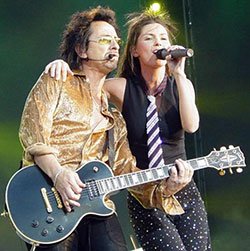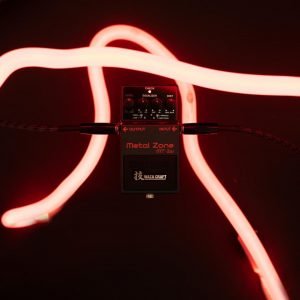Contributed by: Braegen Russell
Guitarist Randall Waller talks to Roland Australia about life as a session musician and touring performer. He explains how he was able to do more with the GT-series of multi effects processors than he ever could have done with compact pedals.
Guitarist, singer, writer and producer, Randall Waller has only ever played music for a living, though he does admit to doing a ‘real’ job once – he says it was a terrible morning.
In the ‘80s, his first band, Avion, were on track to making it big. But it’s hard to keep a band together, and when he found himself a free agent, he packed a guitar, hit the road, and never looked back.
Touring with artists like Sharon O’Neill, Dragon and Bonnie Tyler, Randall eventually found himself in London working with Australian household names like John English and Billy Thorpe.
Things shifted gear from there, when friend Andy Cichon who, by putting Randall’s name forward for a gig that would change his life, also initiated a friendship with one of the biggest names in the music business.
“The gig was for a really big tour, this was a Mutt Lange production so we immediately knew it would be big. They wanted a guitarist who could also sing great harmonies and could compliment the lead singers voice.”
The artist? None other than Shania Twain. “The first tour was in ’88 & ‘89 for the ‘Come on Over’ record which is still the biggest selling album of all time by a female artist. I travelled around 500,000 km during that time. I’ve never been able to sleep on a bus. I’d stay up most nights talking to the driver, while everyone else got their beauty sleep.”
Between albums Randall camped out in Nashville, where he soon found work with people like Keith Urban, and Americana Song writing legend Rodney Crowell.
After another tour with Shania for the ‘Up’ Album he moved back to Australia in 2005 to raise a family. Now playing with Australian Rock legends ‘Rose Tattoo’ and the iconic Angry Anderson, he says he couldn’t be happier.
Randall still has the GT-5 he used when he was playing guitar with Shania. As he recalls, there were 42 patches, many of the songs using 2, often 3 patches.
Our conversation turned to live work, being on the road and, of course, BOSS gear. Randall tells me how the GT-5 (BOSS’s flagship model at that time) worked best for him.
“I would use the internal switching in the GT’s to go from a light rock sound to a heavily chorused, delayed, compressed, almost ‘Andy Summers’ type sound… I would use the expression pedal to do that change in one movement. Rather than jump around, treading on places where I didn’t want to. It would have been impossible to do that kind of change, quickly and change several pedals instantly, any other way. “
Randall is a long time BOSS user “The first multi I had was the ME-5. I bought that in the U.K in ’92 or ‘93, upgraded to the GT-5 in ’96, shortly after it came out. Then a GT-8 for quite a long time, which I sold to Iva Davies (Icehouse) who still uses it today.”
We then talked about the latest BOSS flagship, the GT-100 Version 2, and Randall’s recent experiences with the GT-100. “I’ve been using the GT-100 for the last few months. It has a different user interface to the GT-10 the two screens make it easier to get into the nuts and bolts of the programming.”
When you’re performing regularly, it’s good to streamline your show – eliminate as many potential ‘train-wrecks’ as possible. Quick, accurate, sonic alterations are integral to a slick performance.
“For me, I use these multis’ as programmable compact pedals to obtain the sounds, and control numerous effect changes simultaneously. So rather than having 3 or 4 Blues Drivers, or 18 different delay pedals on a massive pedal board, you can set all the tempos and effects different for each patch and song.”
Can you expand on that answer? “I’d hit a switch and immediately turn the compressor on, the gain of the overdrive down, both sides of the harmoniser up and turn the delay on, the low mid down, and the high mid up. All with just one pedal! There’s no other way to do that for me. I love that flexibility. I also think the switching features the most under rated, and possibly under used functions that these GTs have.”
There are so many different effects in these units, the array of different, colourful noises inside, which enable the guitarist access to a complete palette of sounds to work with, it is easy to think that it may be over whelming.
“I think the best part of working with the GT-100 is that there are more sounds than you would imagine. I go through the factory patch settings, to find the whacky, bizarre sounds that use the combinations I wouldn’t have thought to put together. I’ll admit that I’m ok with using the factory patches as my own! The unique, outrageous sounds they come up with can actually become the crucial building blocks of a track that will end up on an album.”
Did you ever decide to really put the age old debate to bed, that you compromise tonal quality in favour of quantity of sounds, and convenience, even price point?
“When I bought the GT-5 back in the ‘90’s, I already had the BOSS Blues Driver compact, and actually A/B’d it against the Blues Driver in the GT-5. I got the multi to sound even better than the compact. Up until that point, I’d tried a bunch of multis’ from different manufacturers and it seemed that almost always there was a compromise in the gain or overdrive section on them. They always seemed tinny, or too saw toothed buzz saw… just horrid, until I tried the BOSS GT’s. I think the tones in the GT series, in general, have kept the integrity of the individual pedals, to an extraordinary degree.”
Randall Waller has decades of experience programming guitar tones and has written some custom GT-100 Ver. 2 patches for BOSS TONE CENTRAL – you can download them here www.bosstonecentral.com
For more on Randall Waller check out his website www.RandallWaller.com









